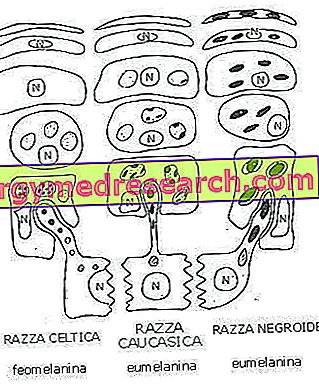Skin color: what does it depend on?
The color of the skin is basically due to the presence of a skin pigment called melanin, the same substance responsible for the browning of the skin when exposed to the sun.
The color of the skin is determined, to a lesser extent, also by the hemoglobin which, when it binds oxygen, gives the blood a bright red color, giving the skin a pink color. Conversely, when the hemoglobin is dissociated the blood takes on a bluish color and this can give the skin a cyanotic (gray-bluish) color. The phenomenon is more evident in fair-skinned individuals.
Carotenoid pigments, present in yellow-orange foods (primarily carrots, followed by apricots, peppers, tomatoes, etc.) also contribute to determining skin color. If an individual's diet is particularly rich in these foods his skin, especially in the palms of the hands, can take on a vaguely yellowish color. One speaks in these cases of carotenosis.
Melanin: synthesis and functions
Melanin is produced by melanocytes, dendritic cells belonging to the basal layer of the epidermis. Their dendrites develop upward and make contact with a fair number of keratinocytes.
The number of melanocytes is about the same, regardless of race. In the aging individual the number of active melanocytes, that is, capable of producing melanin, progressively decreases. This phenomenon becomes striking at the level of the hair, whose graying is linked precisely to the loss of activity of the melanocytes present in the hair follicles.
- MELANIN: pigment responsible for browning of the skin
- MELANOCYTES: cells that produce melanin
- MELANOSOMES: organelles inside melanocytes responsible for melanin synthesis
MELANOGENESIS: melanin production process
- KERATINOCYTES: major component of epidermal cells
- EPIDERMIDE: outer layer of the skin
Melanogenesis is the melanin production process. It is divided into four phases:
- production of melanosomes in melanocytes;
- melanin synthesis in melanosomes;
- transfer of melanosomes from melanocytes to keratinocytes;
- degradation of melanosomes;
- Melanin synthesis is a particularly complex process. We only remember that this synthesis starts from tyrosine, an amino acid that our body is able to produce from phenylalanine which, unlike its derivative, is considered an essential amino acid.
There are two types of melanin, eumelanin (darker and insoluble pigment) and pheomelanin (red-yellowish pigment rich in sulfur). Depending on the type of melanin and the size of the melanosomes, we can distinguish three racial types:
- NEGROIDE: melanosomes are very large and particularly rich in eumelanin
- CAUCASIAN: melanosomes are smaller and contain eumelanin
- CELTIC: melanosmi are acora smaller and contain pheomelanin (very light skin, populations of Northern Europe)
- The next step is to transfer the melanosomes to the keratinocytes. This step is essential since until the melanin remains inside the melanocytes the epidermis does not acquire color.
Only when the melanosomes are released to the keratinocytes does the skin become pigmented.
Initially the melanosomes move along the dendrites: inside the melanocytes there are protein filaments with a contractile capacity, capable of making the melanosomes migrate towards the dendritic apex. At this point the keratinocytes manage to phagocyte the end of the dendrites, releasing the melanosomes.
- In the fourth phase the degradation of the melanosomes contained in the keratinocytes takes place. At this point a distinction must be made between the various racial types.

Within melanocytes melanosomes are separated from each other. Once in keratinocytes they can remain isolated or cluster into clusters called melanosomal complexes (typical of the Celtic and Caucasian phenotype). The whole process is conditioned by the size of the melanosomes and their melanin content.
In the Celtic breed the melanosomes, small and rich in pheomelanin, are easily grouped into melanosomal complexes surrounded by membrane. Inside them particular enzymes are enclosed, capable of degrading the membranes and the melanin itself. Since the Celtic skin is poor in melanin, this degradation occurs almost completely in the deep layers of the epidermis, preventing the pigment from rising and giving the skin its typical pale color.
In the Caucasian race, thanks to the higher melanin content, this degradation is slowed down and less effective in preventing pigment from rising.
In the Negroid breed the melanosomes, rich in eumelanin, remain isolated from each other (unlike the previous cases they do not form melanosomal complexes). This characteristic prevents the degradation of melanin, which easily reaches the stratum corneum, giving the skin its typical dark color.
CONTINUE: Functions of melanin and skin color "



